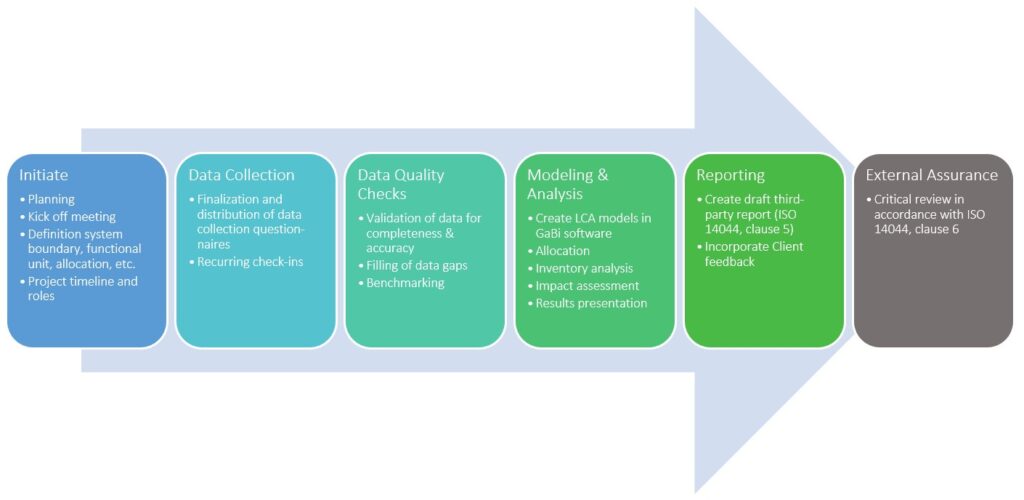What is Life Cycle Assessment (LCA)?
During a Life Cycle Assessment (Life Cycle Analysis), you evaluate the potential environmental impacts throughout the entire life cycle of a product (production, distribution, use and end-of-life phases) or service. Explore the tools to improve LCA practices with Life Cycle Assessment Software.
This also includes the upstream (e.g., supply of parts or services) and downstream (e.g., waste management) processes associated with the production (e.g., production of raw, auxiliary and operating materials), use phase, and disposal (e.g., waste treatment, recycling or incineration).
Life cycle impact assessment (LCIA) covers all relevant inputs from the environment (e.g., ores and crude oil, water, land use) as well as emissions into air, water and soil (e.g., carbon emissions and nitrogen oxides). The International Organization for Standardization provides guidelines and requirements for conducting a Life Cycle Assessment according to ISO 14040 and 14044.
The Main Phases of Life Cycle Assessment
Goal & Scope Definition
In this phase, you define the product or service that you wish to assess, you choose a functional basis for comparison and you define the required level of detail. This step ensures clarity for the entire LCA study process. You then set a goal which determines the scope , including objective, application and audience. Lastly, you determine whether or not there has to be a critical review of that goal.
Inventory Analysis
Here you perform a data compilation and an inventory analysis of extractions from and releases into the environment. This life cycle inventory analysis identifies resources consumed (referred to as “inputs”) and e.g. emissions produced (referred to as “outputs”) throughout the product’s life cycle.
Impact Assessment
In the impact assessment, you classify resource use and emissions generated according to their potential impacts and quantify them for a limited number of impact categories, which you may then assess in terms of their relative importance for the goal of the LCA study.
In other words, you can classify and quantify environmental impacts (e.g., global warming potential / CO2 or other greenhouse gas emissions) to their relevance for defined targets and goals, like climate change impact, decarbonization or acidification impacts.
Interpretation
With the above information, you discuss the results in terms of contributions, relevance, robustness, data quality and limitations, and you systematically evaluate any opportunities for reducing the negative effects of the product(s) or service(s) on the environment while avoiding burden shifting between impact categories or life cycle phases. Identifying and avoiding burden shifting is a core strength of the LCA approach.
For a deeper dive into how LCA transforms industries, explore how LCA drives the automotive sector decarbonization.
Life Cycle Assessment Terminology
System Boundary
This is a description of the activities within the product’s life cycle phases that are included and excluded from consideration.
Product System
The entirety of all activities within the system boundary that are associated with the functional unit.
Functional Unit
Reference unit for scaling the product system based on the function(s) provided. You carry out all assessments based on this unit. Examples include 100 pairs of hands dried (e.g., for paper towels and electric hand dryers), 1 liter of coffee brewed (e.g., for coffee machines), 1,000 pages printed (e.g., for office printers) or 1 ton-kilometer (e.g., for freight transport).
Reference Flow
The amount of product needed to provide the functional unit, expressed in mass, energy, area, volume or any other physical unit. For LCAs that assess intermediate products or raw materials without a specified end use, the reference flow may act as the functional unit (e.g., 1 ton of metal A or chemical B).
Life Cycle Inventory Analysis (LCI)
Collection and analysis of all data necessary to quantify the inputs (resource and energy flows) and outputs (emissions and other releases) into and out of the product system that cross the system boundary.
Life Cycle Impact Assessment (LCIA)
The evaluation of potential environmental impacts based on the LCI analysis results using a comprehensive set of impact categories.
Interpretation
Discussing and evaluating the findings of the LCI and LCIA results to arrive at a conclusion, to compare scenarios (another fundamental function of LCA analysis) and to identify existing improvement potentials.
Reporting
Documenting the LCA study in a comprehensive and transparent manner in accordance with ISO 14044 requirements.
Critical Review
Conformity assessment by one or more independent expert(s) to confirm adherence to the requirements of ISO 14044, thereby increasing the credibility and the ability to communicate the results of the LCA study. The LCA study must be externally reviewed by a panel of three independent experts if a company intends to disclose to the public claims of environmental superiority over a competing product.
Impact Categories
LCA identifies and evaluates a wide range of key impact categories, including:
- Climate change measures GHG emissions, such as CO2 and methane, contributing to global warming. These emissions are causing an increase in the Earth’s absorption of radiation emitted by the sun, increasing the greenhouse effect. This can in turn have adverse impacts on ecosystem health, human health and material welfare.
- Eutrophication (a.k.a., overfertilization)—Eutrophication covers all potential impacts of excessively high levels of macronutrients, the most important of which include nitrogen (N) and phosphorus (P). Nutrient enrichment can cause an undesirable shift in species composition and elevated biomass production in both aquatic and terrestrial ecosystems (e.g., potentially toxic algal blooms). In aquatic ecosystems, increased biomass production may lead to depressed oxygen levels because of the additional consumption of oxygen in biomass decomposition.
- Acidification—A measure of emissions that cause acidifying effects to the environment. The acidification potential is a measure of a molecule’s capacity to increase the hydrogen ion (H+) concentration in the presence of water, thus decreasing the pH value (e.g., acid rain). Potential effects include fish mortality, forest decline and the deterioration of building materials.
- Smog formation (a.k.a., photochemical ozone creation)—A measure of emissions of precursors that contribute to ground level smog formation (mainly ozone O3), produced by the reaction of VOC and carbon monoxide in the presence of nitrogen oxides under the influence of UV light. Ground level ozone can be detrimental to human health and ecosystems and may also damage crops.
- Particulate matter (a.k.a., dust and aerosol emissions)—A measure of particulate matter emissions and precursors to secondary particulates, such as SO2 and NOx from sources like fossil fuel combustion, wood combustion and dust particles from roads and fields. Particulate matter causes negative human health effects, including respiratory illness and an increase in overall mortality rates.
- Ozone depletion—A measure of air emissions that contribute to the depletion of the stratospheric ozone layer (i.e., the ozone hole). Depletion of the ozone leads to higher levels of UVB ultraviolet rays reaching the Earth’s surface with detrimental effects on humans and plants.
How Is Data Collected for Life Cycle Assessment?
- Normally collected through data collection templates.
- Automated data collection through source systems.
- The level of detail (“black box“ vs. individual process steps) depends on data availability, the time available for data collection, the relevance of the data point and the scope of the LCA.
- Sources of primary data include bills of materials/recipes, PLM software, utility bills, meter readings, procurement records, waste inventories, emissions permit reports, equipment specs as well as measurements in production lines.
- Sources of secondary data include LCA databases, technical literature, journal papers, conference presentations, patents, and others.
- All collected data needed to be quality assured and checked for completeness and consistency, e.g., via checks of mass balance, emission profile, energy intensities, water balance and the like.
What Are the Steps Involved in Completing a LCA Study?
The following chart summarizes the overall approach for an LCA study, established as a best-practice approach over decades of performing and delivering quality LCA studies and results to clients from a multitude of different sectors.
By adhering to the LCA methodology, organizations can increase their oversight of relevant impacts, drive credibility and with that enable a path to reliable decarbonization actions by reducing their embodied carbon and enhance sustainability efforts across industries like construction and automotive.






